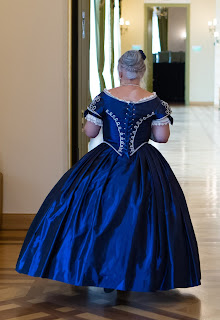Which is not really a court dress, but more like a... kind of difficult to explain, I would say its an upscale version of the Hungarian "folk" dress, but not a folk dress either. There are periods in the Hungarian history, when nationalism flares up, and people want to show their love and support for the country wearing clothing that bears typical Hungarian characteristics, sometimes foreigners wear them to show their support of the Hungarian nation. Like empress Sisi did, when she was crowned as queen of Hungary.
It's basic characteristics, the laced and/or soutached front, the white undershirt, with its lacey sleeves, and the lace apron are the same since the mid 17th century or so, and probably rooted in renaissance dressing. What changes are mostly the shape and undersupport of the skirt, maybe the details, and waistline of the bodice. On this pic there is an 18th century version, in the background, on me a mid 19th century version.
I had such a court dress for a few years now. And I admit I desparately disliked the dress. Most probably its biggest sin is I did not make it. It was made by a young man to show off in the yearly competition of the dressmaker shcool he went to. He asked me to modell it on the competition, I paid for the fabric, its a long story. Anyhow, however talented dressmaker my friend was, the dress, though it looks nice, has a ton of problems.
So at the end it turns out I cannot stand the velvet court dress, I did wear it in Gödöllő castle in december, but I took it off almost crying and saying I never going to wear it again. I understand the beauty and the appeal of it, and I thought once, in the future, I will do one for myself that I will wear with pride, but I need to find the right time, the right fabric, etc.
However, as we were getting ready to the event we did at the "Vigadó", which was a building tour spiced with history of the building, the balls that were done in there and customs, stories of balls of the period, we divided the ages amond us. Early Victorian, which is actually the age of reforms for us, mid- Victorian, the 1860, the 1870-ies and the 1890-ies. Since I got the 1860-ies it was obvious that I need to do something about my dress.
I could not wear the Tardisblue-and-roses gown, because in the summer when I last wore it, we saw that I "quarantined out" of it. I can, kind of, lace myself into it, but it fits bad and it is uncomfortable at my current weight. So a new bodice was in plans anyhow, but as we were getting deeper and deeper into the research and the material we had to get through and learn, it became clear that my period was one of the heydays of that type of the Hungarian dress, so much there were articles about it, in fact that a newspaper called Nefelejcs (Forget me not) did an obituary for the french fashion... So a Hungarian court dress was in order. The skirt of my 1860-ies ballgown still fits me, thankfully I could use it, thus I only had to make a new bodice. Also, back then, when I've made it, I bought plenty of the taffeta, so I even had more than enough leftover for the bodice.
I did make a mock up, that fit surpisingly well, only the waist and the mid back needed adjusting. Usually I call my friend Tilda to help with fitting, but there was no time for that so I enlisted my son. Now, he is a 20 year old young man, and even though he is used to his mother doing crazy things (and making him do crazy things), still looked a bit quizzically at me, when I handed him a box of pins to pin the thing on me... At the end we found that small safety pins work better for him, and he managed to draw the line on the mid back.
By the time, I needed fitting with the half done final piece Norbi was up, but he is not better than Chris with the pins, but he fought them heroically. and managed to help me out there.
Unfortunately, once again I've went through the sewing concentrating getting it ready in time, and forgot to make photoes of the process, but here are some finished pictures.
With this bodice I was trying to fix some of the issues I had with the other dress.
Like I really wanted to have the dress properly finished. On its inside as well as the outside.
The boning channels are made from twill tapes, sewn down either by machine (on the straight front), or by hand everywhere else.
The inside sleeve seam is covered with a bias tape.
The little ears (shank) of the buttons were big enough to thread the lace through, so that is what I did.





























No comments:
Post a Comment